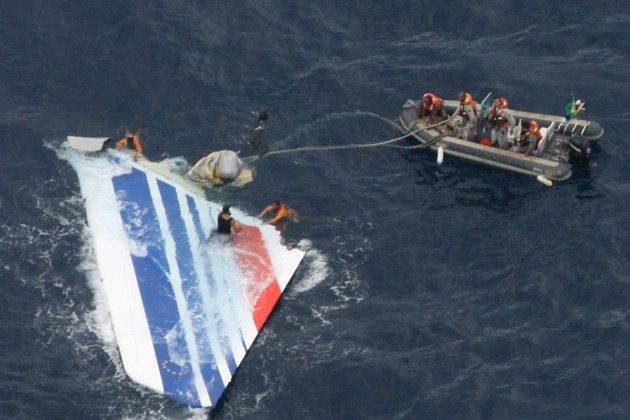Brazil’s Navy sailors recover debris from the missing Air France Flight 447 in the Atlantic Ocean in June 2009. Photo: Brazil Air Force
By Andrea Rothman
March 15 (Bloomberg) — As the search for the missing Malaysian jetliner shifts to the vast expanses of the Indian Ocean, the hunt for an Air France plane that vanished over the Atlantic in 2009 provides some sobering lessons.
Wreckage from the French jet took two years to locate on the seabed even though debris was found floating five days after the plane went missing. In the case of Malaysian Flight 370, a week of searching has produced not a trace of physical evidence.
Parallels between the incidents are limited to Air France Flight 447 disappearing abruptly on an overnight flight between Rio De Janeiro and Paris, and MH370 vanishing in the early hours en route from Kuala Lumpur to Beijing. While surface debris and data downloads quickly pointed to the French plane’s likely fate, it took a deep-sea trawl costing $100 million to locate black-box flight recorders that finally revealed what happened. Searchers in Southeast Asia have even less to go on.
“Here we have no solid information, and nobody’s found any debris to help provide indications,” said Jean-Paul Troadec, who was in charge of France’s BEA air-accident investigating bureau when the AF447 search was under way. “The problem here is, what is the last position?”
In the case of the Air France Airbus Group NV A330 jet, the authorities had an invaluable insight into the plane’s final minutes on June 1 following the transmission of 24 automated breakdown messages. As soon as June 6, a Brazilian rescue ship was already retrieving bodies from the ocean surface.
Military Radars
Views on where to even begin looking for debris from the Malaysian Airline System Bhd. Boeing Co. 777 have changed from one day to the next since the plane’s disappearance, with initial efforts focused on the Gulf of Thailand, the site of its last know position one hour after takeoff.
Subsequent searches also took in the South China and Gulf of Tonkin to the north, before the focus changed completely.
While the transponder responsible for identifying the jet to ground controllers quit working 40 minutes into the flight, information emerging from military radars and satellite systems began to suggest it had changed course and backtracked hundreds of miles west, beyond its original point of origin.
Search efforts moved to the Malacca Strait between Malaysia and Indonesia and most recently to the Andaman Sea, north of Sumatra, and the Bay of Bengal at the northern extremity of the Indian Ocean, a body of water that’s the third-largest in the world after the Pacific and Atlantic.
Trenches
Whereas the Gulf of Thailand is a relatively small sea, often shallower than a 777 is long at about 50-60 meters (165-195 feet), the new area is huge and complex. That makes the search tougher and any retrieval effort more challenging, said Dave Gallo, director of special projects at the Woods Hole Oceanographic Research Institute in Falmouth, Massachusetts.
“It’s akin to searching more than the entire North Atlantic,” said Gallo, whose robots helped find the wreck of AF447. “It’s like Los Angeles to New York to London. And it’s very dynamic topographically — very volcanic, lots of landslides and eruptions and earthquakes, making it an extremely difficult area to move around in.”
While the Andaman Sea has an average depth of about 1,000 meters, far greater than the Gulf of Thailand though still relatively modest versus the 3,900 meters at which AF447 was found, the seabed drops off dramatically to the west. There, a series of trenches marks the geologically volatile boundary between the Eurasian the Indo-Australia continental plates. Beyond lie the depths of the Indian Ocean’s abyssal plane.
Nuclear Submarine
Airbus financially contributed to the search for the Air France aircraft, and only the fourth salvage attempt brought a result in the form of the wreckage and flight-recorder boxes. France even enlisted the help of a nuclear submarine to trawl the seabed on earlier, ultimately futile attempts.
While researchers can use computerized, mathematical models to study currents and winds to help narrow down the search zone from recovered debris, Troadec of the BEA institute said such methods proved futile in the hunt for AF 447.
“We discovered that the currents went every which way,” said Troadec.
Even if the wreckage was to be found in the deep ocean, only a “small club of people” could contemplate reaching the site, according to Gallo, who reckons the search effort on the surface is equally daunting, given that the Boeing wide-body had enough fuel keep flying for at least another 2,500 miles.
“Usually by this point there’s some trace of something to go on, but we have none of that,” he said. “Every night I go to sleep thinking there’ll be new, fresh leads in the morning, but things only seem to go backwards. It seems impossible.”
To contact the reporter on this story: Andrea Rothman in Toulouse at [email protected] To contact the editors responsible for this story: Benedikt Kammel at [email protected] Christopher Jasper
Copyright 2014 Bloomberg.

 Join The Club
Join The Club











